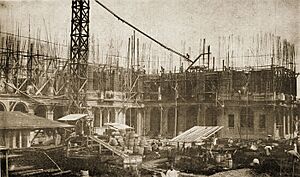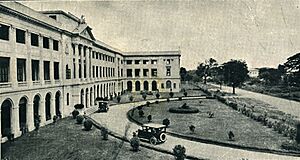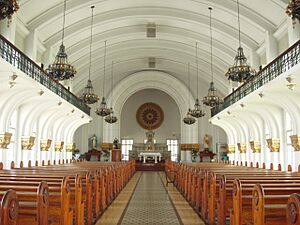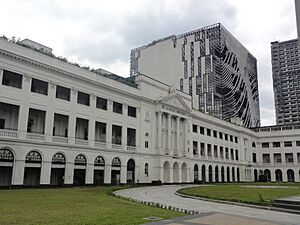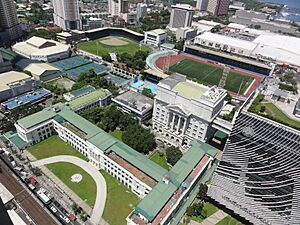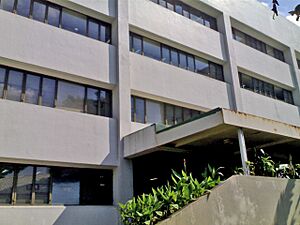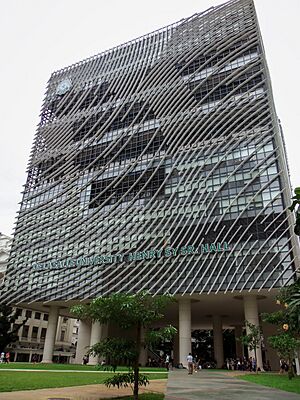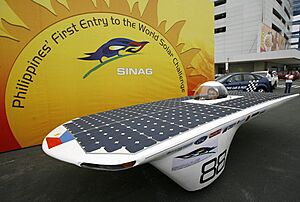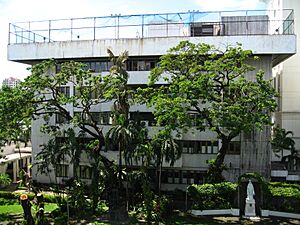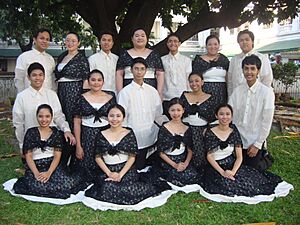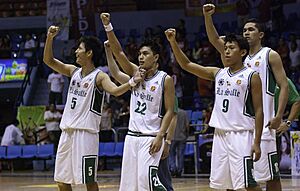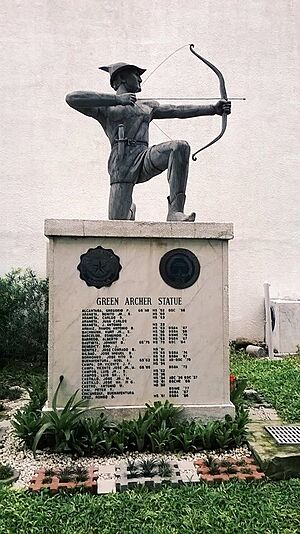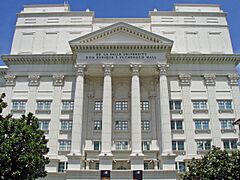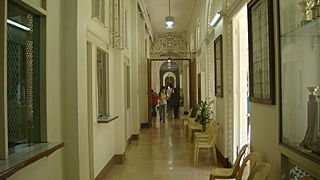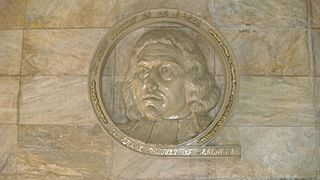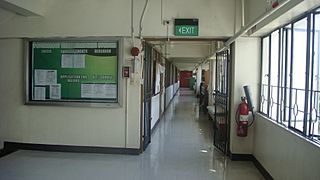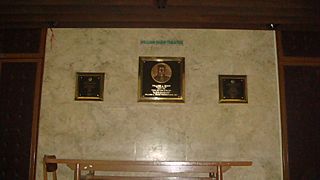De La Salle University facts for kids
|
Pamantasang De La Salle (Filipino)
|
|
 |
|
|
Former name
|
De La Salle College (1911–1975) |
|---|---|
| Motto | Religio, Mores, Cultura (Latin) |
|
Motto in English
|
Religion, Morals, Culture |
| Type | Private, research, non-stock, coeducational higher education institution |
| Established | June 16, 1911 (114 years and 207 days) |
| Founder | Institute of the Brothers of the Christian Schools |
|
Religious affiliation
|
Roman Catholic (Christian Brothers) |
|
Academic affiliations
|
ACUCA ASAIHL ASEACCU AUN IALU IAU IFCU PATE SMIIC UBCHEA UNCOFIN |
| Endowment | ₱286 million (US$4.98 million) |
| Chairman | Senen C. Bacani |
| President | Br. Bernard S. Oca FSC |
|
Academic staff
|
1,500 |
| Students | 23,110 |
| Undergraduates | 18,821 |
| Postgraduates | 4,289 |
| Campus | Main: Manila: Urban 2401 Taft Avenue, Manila, Metro Manila, Philippines 5.45 hectares (54,500 m2) Satellite: Makati: Urban RCBC Plaza, Makati, Metro Manila, Philippines Rufino: Urban University Parkway, Bonifacio Global City, Taguig, Metro Manila, Philippines 0.14 hectares (1,400 m2) Laguna: Suburban LTI Spine Road, Biñan, Laguna, Philippines 50 hectares (500,000 m2) Lian: Suburban Sitio Matuod, Binubusan, Lian, Batangas, Philippines 1 hectare (10,000 m2) |
| Hymn | Alma Mater Hymn |
| Colors | Green and White |
| Nickname | Green Archers |
|
Sporting affiliations
|
|
| Mascots | Archers named Gordo, Flaco, and Sally |
| Lua error in Module:Location_map at line 420: attempt to index field 'wikibase' (a nil value). | |
De La Salle University (often called DLSU or La Salle) is a private, Catholic university in Manila, Philippines. It is run by the Christian Brothers. The main campus is on Taft Avenue in Manila.
DLSU started in 1911 as De La Salle College. It was the first De La Salle school in the Philippines. In 1975, it became a university. DLSU is part of De La Salle Philippines, a group of 16 schools.
At first, it was an all-boys elementary and high school. Later, it began offering college programs. Today, DLSU is known as one of the top universities in the Philippines. It offers many programs for both boys and girls. These programs cover subjects like business, computer studies, and engineering. The university's patron saint is St. John Baptist de La Salle. He founded the Christian Brothers.
The Philippine Commission on Higher Education (CHED) has recognized DLSU for its excellent programs. It is also one of the few schools with the highest level of accreditation from PAASCU. DLSU is a member of important university networks in Asia and worldwide.
Contents
History of De La Salle University
The Philippines was one of the last places in Southeast Asia where the De La Salle Christian Brothers started schools. The Brothers had already opened schools in other Asian countries. At first, they were not sure about opening a school in the Philippines. This was because Americans wanted the school to teach only children from rich families.
The Americans wanted the school to help future Filipino leaders become more like Americans. This idea was different from the original mission of St. John Baptist de La Salle. He believed in providing free education to the poor. The Christian Brothers eventually agreed to open a school in Manila. They felt that even children from wealthy families needed good moral and spiritual training.
The idea for a De La Salle school in Manila came from Archbishop Jeremiah James Harty. He thought a De La Salle school would help spread Catholic education. The Pope supported his request in 1907. In 1910, some Christian Brothers arrived to find a good location. They bought a large property in Paco, Manila.
Early Years
De La Salle College opened on June 16, 1911. Nine Christian Brothers started the school with 125 students. By July, the number of students grew to 175.
In 1912, the college became an official organization. It was allowed to give out high school diplomas. It also started offering a two-year business program in 1920. By 1921, the college had 425 students. Because it needed more space, the college moved to its current location on Taft Avenue in Malate, Manila. In 1931, the two-year business program changed to a four-year Bachelor of Science in Commerce program.
World War II Impact
During World War II, American Christian Brothers were held in a Japanese camp. Other Brothers were allowed to stay and teach at the Taft Campus.
The De La Salle campus first served as a safe place for people and wounded soldiers. But on January 2, 1942, the Imperial Japanese Army took over the campus. They used it as a military base. The campus was badly damaged by bombings. Despite this, classes continued during the Japanese occupation. Students from other schools even shared classrooms at DLSC. The high school classes moved to St. Scholastica's College, Manila in 1943.
Classes at De La Salle stopped by the end of 1944. On February 1, 1945, Japanese soldiers ordered everyone to leave the college. However, Brother Egbert Xavier Kelly refused. He was taken by soldiers on February 7, 1945, and was believed to have been killed. On February 12, 1945, Japanese soldiers entered the campus. They killed 16 of the 17 Christian Brothers and 25 other people living there. Only one Brother and 21 others survived.
After the War
Classes started again in July 1945 with 60 new high school students. One year later, the College of Commerce reopened. Its three-year program became a four-year program.
In 1968, the high school department moved to La Salle Green Hills in Mandaluyong. The College of Commerce helped create the Asian Institute of Management in the same year.
Changes in the 1970s and 1980s
The school continued to change. In 1973, it started accepting both boys and girls. On February 19, 1975, De La Salle College officially became De La Salle University (DLSU). The Grade School Department closed in 1978.
In 1981, DLSU changed its school year to a trimestral system. This means students have three terms instead of two semesters. Students were then called "Lasallians."
Recent History
On September 26, 2010, a grenade exploded outside the DLSU campus. This happened during the Philippine Bar exams held at the university. Many people were injured.
In 2012, De La Salle Canlubang became part of De La Salle University. It was renamed the De La Salle University – Laguna Campus. In 2015, DLSU announced it would open its Manila campus for senior high school students. This was in response to the K–12 education system. Senior High School classes began on June 1, 2016. In 2019, DLSU launched a new online learning system called AnimoSpace.
Campuses
Manila Campus
The main campus is located on Taft Avenue in Malate, Manila. It is part of the University Belt, an area with many other schools. The campus has several buildings, many with a classic design.
- St. La Salle Hall was the first building on campus. It was finished in 1924. This H-shaped building was designed by Tomás Mapúa. It was one of the few buildings that survived the 1945 Battle of Manila. It is the only Philippine building in the book 1001 Buildings You Must See Before You Die.
- St. Joseph Hall was completed in 1956. It used to house the DLSU library.
- St. Miguel Febres Cordero Hall was finished in 1969. It houses the College of Liberal Arts.
- Urbano J. Velasco Hall was completed in 1981. It houses the College of Engineering.
- Don Enrique T. Yuchengco Hall is a nine-story building finished in 2002. It has classrooms, conference rooms, and offices.
- John Gokongwei Sr. Hall houses the College of Computer Studies. It also has a 24-hour study hall.
- William J. Shaw Hall houses the College of Science.
- Br. Andrew Gonzalez Hall is a 20-story building, making it the tallest academic building in the Philippines. It was completed in 2006. It has over 100 classrooms and faculty rooms.
- Enrique M. Razon Sports Center is the main sports facility. It was built in 1998. It has an Olympic-sized pool, track, and courts for various sports.
- Henry Sy Sr. Hall is a 14-story building. It houses the university library, now called the Learning Commons. It was completed in 2012 and opened in 2013. It is the largest university library building in the Philippines.
The DLSU–Manila campus is quite small for its many students. This can lead to crowded elevators. To solve this, DLSU has built taller buildings.
Laguna Campus
The Laguna campus became part of De La Salle University in 2012. It is located in Biñan, Laguna. This large campus was built on land donated by the family of Leandro Locsin. It was first known as De La Salle Canlubang.
The Laguna campus offers many college programs. It also has a pre-school, elementary, and high school. In 2016, DLSU partnered with Ubisoft to open a game development studio there. This studio was the first AAA game studio in the country. However, Ubisoft Philippines moved its office in 2024.
The Laguna campus has roads named after important Lasallian Brothers. Its facilities include:
- Milagros R. del Rosario Building, the first building on campus. It houses offices, labs, and a library.
- Learning Center 1 (LC1), home to the pre-school and elementary levels.
- Integrated School Complex (LC2), home to Grades 5 to 10.
- One Mission Park, a park with a statue of St. John Baptist de La Salle.
- Residence Hall, a dormitory for students.
- Richard L. Lee Engineering Technology Block, a hub for engineering courses.
- George S.K. Ty Advanced Instrumentation Building, with classrooms and research facilities.
- Santuario de La Salle, the world's first Catholic shrine dedicated to St. John Baptist de La Salle. It opened in 2022.
- Enrique K. Razon Jr. Hall, a new center for learning and logistics. It opened in December 2024.
The campus also has sports facilities. These include a football field, track oval, and gymnasium.
Rufino (Bonifacio Global City) Campus
The Rufino Campus is in Bonifacio Global City, Taguig. It is mainly used by the Tañada-Diokno College of Law. This seven-story building has classrooms, an auditorium, and a moot court. It opened in 2017.
Makati (RCBC) Campus
The Makati Extension Campus (MEC) is located in RCBC Plaza in Makati City. This campus is mainly for graduate business students.
Lian Campus
The Lian campus is a research facility in Lian, Batangas. It is known as the De La Salle University – Br. Alfred Shields Ocean Research (SHORE) Center Marine Station. It is used for field activities and research in coastal areas. It opened in 2013.
Organization
| Directors | |||
|---|---|---|---|
| Name | Tenure of office | ||
|
|
|||
| Blimond Pierre Eilenbecker | 1911–1912 | ||
| Goslin Camille Thomas | 1912–1915 | ||
| Acisclus Michael Naughter | 1915–1919 | ||
| Albinus Peter Graves | 1919–1921 | ||
| Presidents | |||
| Name | Tenure of office | ||
|
|
|||
| Albinus Peter Graves | 1921–1923 | ||
| Acisclus Michael Naughter | 1923–1927 | ||
| Celba John Lynam | 1927–1930 | ||
| Dorothy Joseph Brophy | 1930–1933 | ||
| Marcian James Cullen | 1933–1936 | ||
| Flannan Paul Gallagher | 1936 | ||
| Egbert Xavier Kelly | 1937–1945 | ||
| Lucian Athanasius Reinhart | 1945–1950 | ||
| Antony Ferdinand Kilbourn | 1946 (acting) | ||
| Andelino Manuel Castillo | 1950 (acting) | ||
| Hyacinth Gabriel Connon | 1950–1959 | ||
| Denis of Mary Ruhland | 1959–1961 | ||
| Crescentius Richard Duerr | 1961–1966 | ||
| Hyacinth Gabriel Connon | 1966–1978 | ||
| Andrew Gonzalez | 1978–1991 | ||
| Rafael Donato | 1991–1994 | ||
| Andrew Gonzalez | 1994–1998 | ||
| Rolando Ramos Dizon | 1998–2003 | ||
| Carmelita Quebengco | 2003–2004 | ||
| Armin Luistro | 2004–2010 | ||
| Narciso S. Erguiza Jr. | 2010–2012 | ||
| Ricardo Laguda | 2012–2015 | ||
| Raymundo B. Suplido | 2015–2021 | ||
| Bernard S. Oca | 2021–present |
|
|
| Notes | Names in italics were acting presidents. | ||
|
|
|||
| Reference | |||
How DLSU is Managed
DLSU is run by a group called the Board of Trustees. This board chooses the university president. The president of De La Salle University must be a Christian Brother and have a PhD.
Since 1911, De La Salle University has had 24 presidents. Brother Bernard S. Oca is the current president. He started his term on August 1, 2021. Two former presidents, Brother Andrew Gonzalez and Brother Armin Luistro, also served as secretaries of the Philippine Department of Education.
School Connections
De La Salle University is the oldest member of De La Salle Philippines. This group connects 16 Lasallian schools. DLSP is part of a worldwide network of Lasallian schools. There are over 3,000 Christian Brothers and 90,000 teachers. They help run over 1,100 schools in 80 countries. More than a million students attend these schools.
DLSU is also part of many international university groups. These include the ASEAN University Network and the International Association of Universities. It is also a member of local groups like the South Manila Inter-Institutional Consortium.
Academics
De La Salle University offers many undergraduate and graduate programs. These are spread across its seven colleges and one school. It was one of the first schools in the Philippines to offer a degree in mechatronics and robotics. As of 2025, DLSU has 15 research centers.
In the 2021–2022 school year, DLSU had 1,500 faculty members. It had 23,110 students in total. This included 18,821 undergraduate students and 4,289 graduate students.
The College of Liberal Arts and the College of Business are the oldest parts of the university. They were started in 1918 and 1920. The College of Liberal Arts was first called the College of Arts and Sciences. In 1982, the science departments formed their own College of Science. The College of Business was first known as the College of Commerce. In 2011, it became the Ramon V. del Rosario College of Business.
The Br. Andrew Gonzalez College of Education started offering graduate degrees in 1936. Undergraduate education degrees began in 1959. The Gokongwei College of Engineering was created in 1947. The College of Computer Studies was formed in 1981.
The College of Law and the School of Economics are the newest parts of the university. Both were started in 2010. The College of Law was renamed the Tañada-Diokno College of Law in 2022. It focuses on environmental law and human rights law. The School of Economics separated from the College of Business in 2010.
Grading System
DLSU uses a grading system from 4.0 (excellent) to 0.0 (fail). Students who achieve high grades can graduate with honors. Graduation ceremonies happen in February, June, and October.
Tuition and Financial Aid
DLSU's tuition fees are among the highest in the Philippines. The cost per year can range from about ₱205,000 to ₱225,000.
DLSU offers many scholarships and financial aid programs. For example, top students from De La Salle Philippines schools can get full scholarships. Children of military personnel who died or were injured in duty also get benefits. The university also gives discounts to children of staff, athletes, and student publication editors. Students from families with lower incomes can also get financial help. The top 100 students in the De La Salle College Admission Test (DCAT) receive full scholarships.
Reputation and Rankings
DLSU is considered one of the most respected universities in the Philippines. As of 2025, QS World University Rankings places DLSU 654th globally. It ranks 163rd in Asia. DLSU has been on the QS rankings since 2005.
Times Higher Education (THE) also includes DLSU in its rankings. In 2019, DLSU appeared in the THE World University Rankings for the first time. It was one of only two Philippine universities on the list. As of 2025, DLSU is in the 1501+ bracket globally and 601+ in Asia.
As of 2025, DLSU is ranked first in the Philippines by the Webometrics Ranking of World Universities. It is also ranked third by the SCImago Institutions Rankings (SIR). EduRank ranks DLSU second among Philippine universities.
The Commission on Higher Education (CHED) has named DLSU a Center of Excellence in many subjects. These include biology, chemistry, and information technology. It is also a Center of Development in fields like political science and engineering. DLSU is one of 40 schools with "autonomous status" from CHED. This means it can create new courses without needing CHED's approval first.
DLSU is one of only two schools with the highest accreditation (Level IV) from PAASCU. As of 2025, 11 of DLSU's programs have Level IV accreditation.
Libraries and Collections
The college library started in 1956. It was first located in St. Joseph Hall. The library now has many books and other materials. It has a large collection of books on language, literature, and fine arts. The De La Salle University Library is now called the Learning Commons. It is located in the 14-story Henry Sy Sr. Hall. This is the largest university library building in the Philippines. The Learning Commons takes up floors 5 to 13.
The University Archives keeps historical materials about the university. It has old records, special collections, and faculty publications. Its museum collection includes over 600 ceramic items from Southeast Asia. It also has rare Philippine banknotes and coins. The museum also has over 200 artworks. Many of these collections were donated by famous Lasallians.
The Museum also has a collection of Philippine modern art. This collection was donated by the family of Doreen Fernandez. It includes over 400 works by many artists. Ten of these artists are National Artists of the Philippines.
Research
The De La Salle University Science Foundation helps fund research at DLSU. It provides grants to faculty and scholarships to students. In 2008, its total assets were worth over ₱8.5 billion.
DLSU is a Zonal Research Center for CHED. This means it helps evaluate research proposals for funding.
The College of Computer Studies has a center for "Empathic Human-Computer Interactions." This center studies how to create machines that can react to human emotions. This research is often done with Osaka University.
The Center for Micro-Hydro Technology designs small hydro generators. These generators help bring electricity to remote areas.
DLSU engineering students and faculty built the only two solar cars in the Philippines: SINAG and SIKAT. SINAG competed in the 2007 World Solar Challenge. SIKAT is an improved version.
The College of Engineering also researches biodiesel and sustainable technology. In 2020, the university started a project to develop a space suit outer layer from Abacá fiber. This project is funded by the DOST. In the same year, DLSU won money from the UK government for research on turning wastewater into fertilizer.
In March 2020, DLSU was named the most productive research university in the Philippines. This was based on its publications in the Scopus database. In 2019, DLSU published over 600 Scopus-indexed works. This was the most by any Philippine school in one year. In September 2024, a DLSU student won the James Dyson Award in the Philippines. He created an underground monitoring system.
Student Life
As of 2010, the Council of Student Organizations had 39 student groups. This council helps organize school activities.
The LaSallian and Ang Pahayagang Plaridel are the official student newspapers. They are written in English and Filipino. Other student media groups include Malate Literary Portfolio and Green Giant FM.
Performing Arts
The De La Salle University Chorale is the main choir group. Since 1987, it has won many international awards. These include prizes from the Llangollen International Musical Eisteddfod.
The La Salle Dance Company – Street was the first champion of the UAAP Street Dance Competition. They have won the most titles in this competition. They also represent the Philippines in the World Hip Hop Dance Championships.
The Harlequin Theatre Guild is the official theater group. It performs plays by famous writers. Other groups include the De La Salle Innersoul and Lasallian Youth Orchestra.
Athletics
De La Salle has many sports teams. They compete in sports like basketball, volleyball, and football. In 1924, De La Salle College was a founding member of the National Collegiate Athletic Association (NCAA). It won five championships there. In 1986, De La Salle University joined the University Athletic Association of the Philippines (UAAP). Since then, DLSU has won three UAAP General Championships.
Alma Mater Hymn
In 1961, Brother Stephen Malachy and Brother Bonaventure Richard composed a song. This song became the "Alma Mater Hymn." It was first sung at a graduation in 1964. It was later adopted by the NCAA basketball team. The song is now sung by all Lasallians at school events. DLSU was the first school in the Philippines to sing its Alma Mater Song after every game.
Animo La Salle
Animo means "Spirit to Fight." It is also known as the "La Salle Spirit." Animo La Salle is the school's battle cry. It comes from the Lasallian spirit of "Faith & Zeal." The "Faith" is shown by a shining star. The "Zeal" is shown by three broken chevrons. These symbols are from the ancient family coat of arms of St. John Baptist de La Salle. The family motto, Indivisa Manent, means "Permanently Indivisible." This motto is now "One La Salle" for De La Salle Philippines.
Gallery
-
St. John Baptist de La Salle, universal patron of teachers
See also
 In Spanish: Universidad de La Salle-Manila para niños
In Spanish: Universidad de La Salle-Manila para niños
- De La Salle Brothers
- De La Salle Brothers Philippine District
- De La Salle Philippines
- John Baptist de La Salle
- Lasallian educational institutions
- List of colleges and universities in Metro Manila


